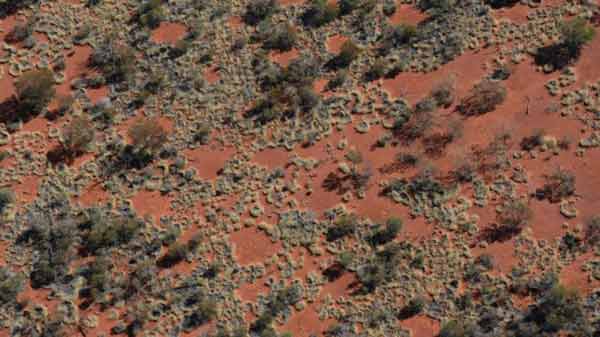
Pilbara, Australia (BBN)-Researchers say the discovery of "fairy circles" in the Australian outback has brought them closer to solving one of nature's mysteries.
The grass-rings that pockmark southern Africa's Namib Desert have perplexed scientists for decades, reports BBC.
A popular theory was that termites engineered the circles in and around the Namib.
But the fairy circles found in Western Australia's remote Pilbara region casts doubt on this explanation.
Stephan Getzin from the Helmholtz Centre for Environmental Research, said they were "a missing link in the debate about the origin of Namibian fairy circles".
"Because in Australia we find an identical fairy circle pattern, but without any explanatory correlation to termite or ant activity."
OSTRICHES OR UFOS?
The termite theory holds that the insects clear patches of ground by eating the roots of short-lived grasses.
The bare patches become rain traps, with water held just below the ground's surface sustaining both the termites and rings of grasses, ensuring their survival in dry conditions.
But Dr Getzin, lead author on a paper published in the journal Proceedings of the National Academy of Sciences, said the plants were more likely self-organising to compete for scarce water resources, forming the patchy honeycomb shapes to combat "water-stress".
"More and more, ecologists are actually realising that distinct vegetation patterns are a population-level consequence of competition for scarce water that is not enough to sustain a complete vegetation coverage and thus causes specific pattern morphologies of vegetation and consequently bare soil," Dr Getzin said.
Ostriches, toxic plants and gases have also been put forward as explanations for the circles, which local Himba bushmen in the Namib desert saw as footprints of the gods.
More recently, internet conspiracy theorists have speculated that UFOs may have produced the distinctive patterns.
'CHICKEN POX'
Australian environmental scientist Bronwyn Bell spotted the "spectacular" circles on a work trip and wondered why they only occurred in one particular part of the Pilbara region.
She consulted local botanists and ecologists, but no-one could explain the phenomenon.
"I just called them chicken pox," Bell told the BBC.
It wasn't until Dr Getzin published a paper in 2014 that she thought she may have found the answer and gave him a call.
"I was pretty excited because I thought it was the same thing," she told the BBC.
After weeks of email exchanges with Bell, Dr Getzin left wintry Germany for the Australian outback, where temperatures hovered around 47C (117F).
He spent almost two weeks in the arid landscape near the Newman township.
After months of modelling and number crunching, the paper Dr Getzin co-authored was published this week.
But he does not believe the puzzle of the fairy circles is solved.
"I would say they are still a mystery because the brand new discovery needs to be further investigated. The same holds for the Namibian fairy circles. Science works generally pretty slowly," he said.
Share this story About sharing
BBN/SK/AD